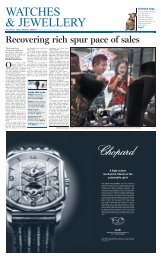BrandZ Top 100 2008 - WPP
BrandZ Top 100 2008 - WPP
BrandZ Top 100 2008 - WPP
Create successful ePaper yourself
Turn your PDF publications into a flip-book with our unique Google optimized e-Paper software.
Sector Highlights<br />
BRANDZ <strong>Top</strong> <strong>100</strong> Brand Ranking | <strong>2008</strong><br />
In addition to the <strong>Top</strong> <strong>100</strong> Ranking, Millward Brown Optimor developed <strong>2008</strong> rankings for 16 product categories including<br />
spirits (new for <strong>2008</strong>) and personal care (which now incorporates deodorants). We also separated financial institution<br />
brands from those in the insurance category.<br />
Those sectors that experienced strongest growth in <strong>2008</strong> are:<br />
1<br />
2<br />
3<br />
4<br />
5<br />
CATEGORY<br />
Mobile Operators<br />
Technology<br />
Personal Care<br />
Fast Food<br />
Luxury<br />
BRAND VALUE GROWTH<br />
35%<br />
33%<br />
27%<br />
27%<br />
24%<br />
Below is an overview of key trends in each category. Refer to page 10 for full category rankings:<br />
Apparel (+23%)<br />
Sports and online retailing are the driving force behind the apparel industry, contributing to growth in footwear and<br />
clothing. Consumers are increasingly happy to wear sports brands whether they play sports or not. Global sporting<br />
events like the World Cup and the Olympics have thrust the industry into the limelight. In China, an interest in Western<br />
sporting events and an increase in disposable income created opportunities for Western sports brands. Retailers are<br />
focusing on online channels as more and more consumers turn to e-retailing<br />
Beer (+24%)<br />
Smoking bans, shrinking core markets, and competition from alternative alcoholic beverages weakened Western<br />
beer markets. The World Cup and an unusually hot summer softened the blow. Beer companies turned their focus<br />
to emerging markets that continue to drive substantial growth for the category. Domestic beer brands from emerging<br />
markets are also growing. The success of Brazilian brands Skol and Brahma exemplify this trend. In developed markets,<br />
local beer brands faced stagnant volume sales as opposed to imported beers that experienced strong growth. In the<br />
U.S., preference for imported premium beers and healthier options led to the development of a “luxury imported light”<br />
range whose sales were twice as strong as those of regular imported beers. As a whole, brewing companies are consolidating<br />
in order to retain market share at home and expand abroad.<br />
6
















